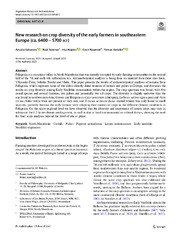Prikaz osnovnih podataka o dokumentu
New research on crop diversity of the early farmers in southeastern Europe (ca. 6400 − 5700 BCE)
| dc.creator | Sabanov, Amalia | |
| dc.creator | Soteras, Raül | |
| dc.creator | Hajdas, Irka | |
| dc.creator | Naumov, Goce | |
| dc.date.accessioned | 2023-10-23T12:21:00Z | |
| dc.date.available | 2023-10-23T12:21:00Z | |
| dc.date.issued | 2023 | |
| dc.identifier.issn | 0939-6314 | |
| dc.identifier.issn | e1617-6278 | |
| dc.identifier.uri | http://reff.f.bg.ac.rs/handle/123456789/5059 | |
| dc.description.abstract | Pelagonia is a mountain valley in North Macedonia that was densely occupied by early farming communities in the second half of the 7th and early 6th millennium bce. Archaeobotanical analysis is being done on material from three sites there, Vrbjanska Čuka, Veluška Tumba and Vlaho. This paper presents the results of archaeobotanical analyses of remains from Pelagonia, which represent some of the oldest directly dated remains of cereals and pulses in Europe, and discusses the results on crop diversity among Early Neolithic communities within the region. The crop spectrum was broad, with five cereal species and several varieties, two pulses and potentially two oil crops. The diversity is slightly narrower than the one found in southwestern Asia, Greece and Bulgaria as Cicer arietinum (chickpea), Lathyrus sativus (grass pea) and Vicia ervilia (bitter vetch) were not present or very rare, and Triticum aestivum/durum (naked wheat) was only found in small amounts, probably because the early farmers were adapting their choices of crops to the different climatic conditions in Pelagonia. On the micro-regional level we have observed that the diversity and importance of certain crops may vary in relation to the 8.2 ka bp climate cooling event, as well as due to local environmental or cultural factors, showing the need for finer scale analyses beyond the level of site or phase. | sr |
| dc.language.iso | en | sr |
| dc.publisher | Springer link | sr |
| dc.rights | openAccess | sr |
| dc.rights.uri | https://creativecommons.org/licenses/by/4.0/ | |
| dc.source | Vegetation History and Archaeobotany | sr |
| dc.subject | North Macedonia | sr |
| dc.subject | cereals | sr |
| dc.subject | pulses | sr |
| dc.subject | Papaver somniferum | sr |
| dc.subject | Linum usitatissimum | sr |
| dc.subject | Early Neolithic | sr |
| dc.subject | Neolithic expansion | sr |
| dc.title | New research on crop diversity of the early farmers in southeastern Europe (ca. 6400 − 5700 BCE) | sr |
| dc.type | article | sr |
| dc.rights.license | BY | sr |
| dc.identifier.doi | 10.1007/s00334-023-00940-2 | |
| dc.identifier.fulltext | http://reff.f.bg.ac.rs/bitstream/id/12464/bitstream_12464.pdf | |
| dc.type.version | publishedVersion | sr |

